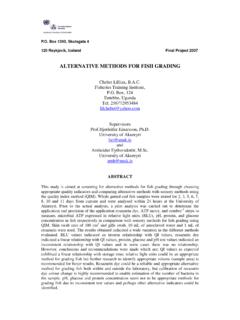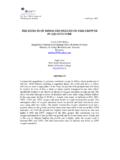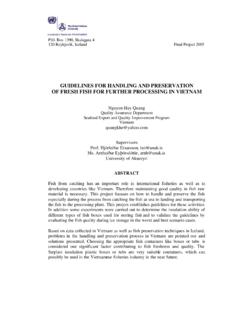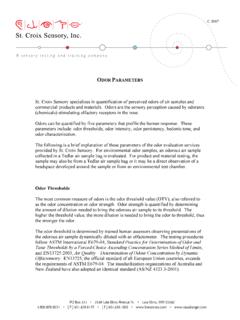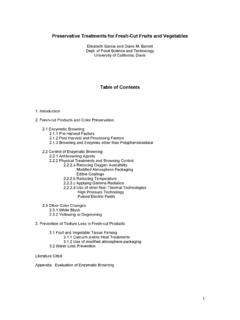Transcription of EVALUATION OF SUITABLE CHEMICAL METHODS …
1 PO Box 1390, Skulagata 4 120 Reykjavik, Iceland Final Project 1998 EVALUATION OF SUITABLE CHEMICAL METHODS FOR SEAFOOD PRODUCTS IN MOZAMBIQUE Carlos Riquixo Minist rio de Agricultura e Pescas Direc o Nacional de Pescas Servi os Provinciais de Administra o Pesqueira-Maputo Tel. 258-1-428194/425678, Fax: 258-1-420335 Maputo- Mozambique Supervisor: Sigurdur Einarsson, Icelandic Fisheries Laboratories ABSTRACT EVALUATION of SUITABLE CHEMICAL METHODS for seafood products were investigated with respect to their accuracy and suitability for determination of additive in seafood products, freshness, nutritional value and scombroid poisoning in fish in Mozambique. METHODS were tested using different fish species and deep shrimp at various freshness stages. The samples were from Iceland and were kept in insulated plastic boxes and in the most aseptic manner, some of them for subsequent microbiological, sensorial and CHEMICAL analyses.
2 The METHODS selected were simple, rapid and inexpensive. Volhard titration and Mohr METHODS were used for salt determination and enzymatic method for sulphite determination . The enzymatic method for sulphite determination was based on the oxidation of sulphite ion to sulphate by oxygen in the presence of sulphite oxidise. Quantitative total volatile basic nitrogen (TVBN) and trimethylamine (TMA) METHODS were performed. For the TMA the procedure included a deproteinisation of primary and secondary amine using formaldehyde at alkaline pH and finally steam distillation of TMA. TVB and TMA were also performed using Flow Injection Gas Diffusion (FIGD) methodology. Due to unsteady baseline on the chart recorder the TMA procedure needed more time than TVB. The TVB could however be determined successfully. Good correlation was found between following METHODS : MgO, TCA-extract steam distillation with FIGD for TVB determination and FIGD with Picric acid for TMA determination .
3 Kjeldahl and fluorometric METHODS were used for protein and histamine determination respectively. The assay of histamine consisted of histamine extraction with methanol, purified by cation-exchange resin and determination by photoflurometer. All analyses were performed with standardised solutions and reagents of purified grade. For each determination different CHEMICAL METHODS were used and the results were compared. It was concluded that the Volhard, Mohr, enzymatic, TCA-extract steam distillation, FIGD and MgO METHODS were SUITABLE for and applicable to present Mozambican conditions. Requixo TABLE OF CONTENT LIST OF LIST OF LIST OF 1 2 REVIEW QUALITY ASSURANCE OF SAMPLING AND SAMPLE QUALITY ASSURANCE IN THE DATA AND REPORTED SALT (NACL) ..10 TOTAL VOLATILE BASES NITROGEN (TVBN) AND TRIMETHYLAMINE (TMA)..12 RELATION BETWEEN SENSORY AND CHEMICAL 3 MATERIAL AND COMPARISON OF SALT determination Volhard Mohr Chloride titrator EVALUATION OF ENZYMATIC METHOD FOR SO2 EVALUATION OF TVB AND TMA METHODS MONITORING THE CHANGES OF FISH FILLETS OF HERRING AND SHRIMP KEPT AT 0 C AND 5 Comparison of TVB and TMA levels of Fish in the same stage of TVB assay of herring and shrimp by TCA-extract steam distillation TVB assay of herring and shrimp by FIGD TVB-N assay of shrimp by the Struer automatic distillation TMA assay of herring by TCA-extract steam TMA assay of herring by FIGD TMA assay of herring and shrimp by picric acid Relation between sensory and CHEMICAL EVALUATION OF PROTEIN CONTENT AND DIGESTIONS EVALUATION OF HISTAMINE CONTENT BY DIFFERENT FISH HANDLING 4 COMPARISON OF SALT determination RESULTS OF EVALUATION OF ENZYMATIC RESULTS OF EVALUATION OF TVB
4 AND TMA METHODS MONITORING THE CHANGES OF FISH FILLETS OF HERRING AND SHRIMP KEPT AT 0 C AND 5 Comparison of TVBN and TMA levels in the same stage of fish Results comparison of TVB Results comparison of TMA Results of freshness comparison of herring kept at 0 C and 5 Freshness comparison of herring and Results of relation between sensory and CHEMICAL RESULTS OF EVALUATION OF PROTEIN CONTENT AND DIGESTION UNU-Fisheries Training Programme 2 Requixo RESULTS OF EVALUATION OF HISTAMINE CONTENT BY DIFFERENT HANDLING 5 DISCUSSION OF RESULTS AND CONCLUSIONS ..50 COMPARISON OF SALT determination EVALUATION OF ENZYMATIC METHOD FOR SO2 EVALUATION OF TVB AND TMA METHODS MONITORING THE CHANGES OF FISH FILLETS OF HERRING AND SHRIMP KEPT AT 0 C AND 5 RELATION BETWEEN SENSORY AND CHEMICAL EVALUATION OF PROTEIN CONTENT AND DIGESTION EVALUATION OF HISTAMINE CONTENT BY DIFFERENT FISH HANDLING 6 LIST OF APPENDIX 1: REFERENCE OF SELECTED CHEMICAL APPENDIX 2: TABLE IN QUANTAB UNITS.
5 58 UNU-Fisheries Training Programme 3 Requixo LIST OF FIGURES Figure 1. The difference between the shaking and boiling METHODS to determine sodium chloride by the volhard titration method in sample of light salted fillets Figure 2. Results from the Volhard and the Mohr METHODS against expected values in salted water Figure 3. Results of chloride titrator method and expected values in salted water Figure 4. Differences between TVB and TMA levels in 3 samples of haddock kept at 0 C in the same period of Figure 5. TVB analytical METHODS (TCA-extract , FIGD) used to determine freshness of herring that was stored at 0 C for up to 13 Figure 6. TVB analytical METHODS (TCA-extract and FIGD) used to determine freshness of herring that was stored at 5 C for up to 11 Figure 7. TVB analytical METHODS (TCA-extract, MgO and FIGD) used to determine freshness of shrimp that was stored at 0 C for up to 11 Figure 8. TVB analytical METHODS (TCA-extract, MgO and FIGD) used to determine freshness of shrimp that was stored at 0 C for up to 8 Figure 9.
6 Comparison of TMA results of herring stored at 0 C for up to 13 days by using TCA-extract, FIGD and Picric acid Figure 10. Comparison of TMA results of herring stored at 5 C for up to 13 days by using TCA-extract, FIGD and Picric acid Figure 11. The difference of TVB levels of herring kept at 0 C and 5 C for up to 13 days using FIGD as TVB- freshness analytical Figure 12. The difference of TMA values of herring stored at 0 C and 5 C for up to 13 days using the FIGD as TMA analytical Figure 13. The difference of TVB levels between herring and shrimp kept at 0 C for up 10 Figure 14. The difference of TVB levels between herring and shrimp kept at 5 C for up 10 Figure 15. Correlation between the decomposition index and TVBN levels for cod stored at 0 48 Figure 16. Correlation between the decomposition index and TMA levels for cod stored at 0 Figure 17. Correlation between decomposition index and P ratio (TMA/TVB x100) for cod stored at 0 UNU-Fisheries Training Programme 4 Requixo LIST OF TABLES Table 1.
7 Results of salt determination using shaking method by the Volhard titration method in samples of light salted fillets of Table 2. Results of salt determination using boiling method by the Volhard titration method in samples of light salted fillets of Table 3. Salt determination for accurate EVALUATION of Volhard method using samples of salted water solutions with known salt Table 4. Differences between Volhard and Mohr METHODS using the same samples of salted water Table 5. Results of salt determination using chloride titrator method in samples of salted water Table 6. Expected and experimental results of SO2 using enzymatic Table 7. TVB results of three samples of haddock using FIGD Table 8. TMA results of three samples of haddock using the FIGD Table 9. Results of TVB levels of herring using TCA-extract and FIGD METHODS ..38 Table 10. TVB and TMA results of shrimp kept at 0 C and 5 C during 10 days using TCA-extract, FIGD and MgO Table 11.
8 TMA-results of herring kept at 0 C and 5 C for up to 13 days using TCA-extract and FIGD Table 12. TMA results of herring and shrimp kept at 0 C and 5 C using picric acid Table 13. Perishable comparison of Herring and shrimp both kept at 0 C and 5 Table 14. Sensory and CHEMICAL results of cod stored at 0 C during 15 Table 15. Results of protein content in the samples of Cod, capelin, Sucrose+ Acetanilide and Table 16. Results of histamine from four different UNU-Fisheries Training Programme 5 Requixo 1 INTRODUCTION Shrimp processing is an important sector in the Mozambican economy. Thus the demand for research and development work in this sector is expected to increase in Mozambique. Knowledge and experienced personnel in marine fish processing are key elements in this connection. A practical overview of different CHEMICAL METHODS to evaluate freshness quality of seafood products especially important. Therefore an EVALUATION of SUITABLE CHEMICAL METHODS for the determination of additives in seafood, freshness, nutritional value and scombroid poisoning of fish in Mozambique was the subject of this study, which will be of relevance to the national program in the following ways: 1.
9 Increase the confidence in the analytical results; 2. Increase the demand of research; 3. Provide guidelines for a quality assurance system in the CHEMICAL laboratory; 4. Provide information for chemists to rationalise laboratory operations; 5. Increase the quality of national fish production for national and international market. Different CHEMICAL METHODS were investigated and compared with respect to their accuracy and suitability in Mozambique. Although a detailed organoleptic inspection is usually sufficient to determine the freshness of intact refrigerated or processed fish, CHEMICAL analyses are indispensable for the assessment of quality. Thus during this study the changes in the levels of TVBN and TMA during fish decomposition and relations between sensory and CHEMICAL analyses were investigated. Most laboratories have determined the sulphite content with (modified) Monier-Williams method. Thus the accurate EVALUATION of enzymatic method for SO2 determination was investigated for comparability with a modified Monier-Williams method.
10 Investigations were also done for protein and histamine content. Since the histamine is neither volatile nor destroyed by cooking, a convenient method of detecting it in seafood samples is needed, particularly where decomposition is suspected. Therefore EVALUATION of histamine content resulting from different handling METHODS of the sample were investigated, which will be a basis for education on hygiene handling of raw material and proper process control of product. From these reasons, the purpose of this report is to provide important recent information on quality assurance in the laboratory concerning CHEMICAL aspects relating to the food industry. The report is organized and written to call attention to recognized practices and procedures. It is designed to provide useful guidelines for CHEMICAL analysis and provides information for chemists to rationalize laboratory operations.


